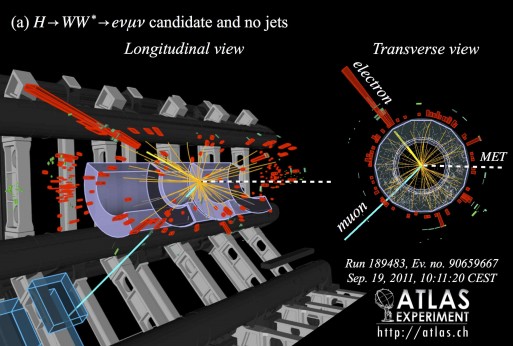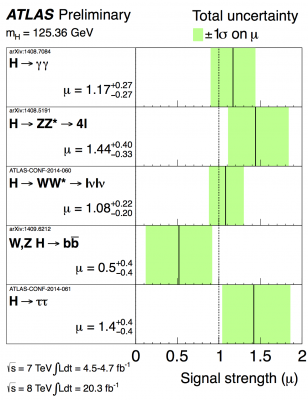New ATLAS precision measurements of the Higgs boson: Observation of WW decay
7 October 2014 | By

The discovery in 2012 by the ATLAS and CMS experiments at CERN of a Higgs boson marked an important milestone in the history of particle physics. It confirmed a key prediction of the Standard Model, the theory that describes fundamental particles and their interactions.
The Standard Model makes many different predictions regarding the production and decay properties of the Higgs boson, most of which can be tested at the Large Hadron Collider (LHC). Since the discovery, experimentalists from the ATLAS collaboration have analysed the complete dataset recorded in 2011 and 2012, have improved the calibration of the detector, and have increased substantially the sensitivity of their analyses.
The new measurements constitute the most stringent tests of the Standard Model Higgs sector presented by ATLAS up until now. They feature updated measurements of the decay of the Higgs boson to pairs of photons and Z bosons, both recently submitted to Physical Review D, and the observation of the decay of the Higgs boson to pairs of W bosons at a level of significance exceeding 6 standard deviations.

The signal strength μ represents the ratio of the observed Higgs production and decay rate to the Standard Model prediction. A μ value consistent with one signifies that the measurement is in agreement with the Standard Model prediction. ATLAS measures signal strengths of μ=1.17 ± 0.27 for the diphoton channel, μ=1.44+0.40-0.33 for the ZZ channel, and μ=1.08+0.22-0.20 for the WW channel, consistent with Standard Model predictions.
Another important prediction of the Standard Model is that the coupling of the Higgs boson to fermions (matter particles) is proportional to their mass. The new results presented by ATLAS, covering Higgs decays to pairs of b quarks and tau leptons, provide strong evidence of this coupling to fermions. The level of significance observed in the tau lepton and b quark decay channels correspond to 4.5 and 1.4 standard deviations, respectively. The measured signal strengths are found to be μ = 0.52+0.40-0.37 for the b quark channel and μ = 1.42+0.44-0.38 for the tau lepton channel. Within their uncertainties, all results are in agreement with the Standard Model.
After a two-year shutdown, the LHC will restart with higher energy beams in 2015 and will produce many more Higgs bosons to analyse. This will allow the ATLAS experimentalists to improve substantially the precision of Higgs measurements and will provide them with new opportunities to search for other types of Higgs bosons predicted by theories beyond the Standard Model.
The new Higgs boson measurements were presented in a dedicated seminar at CERN on Oct 7, 2014.



